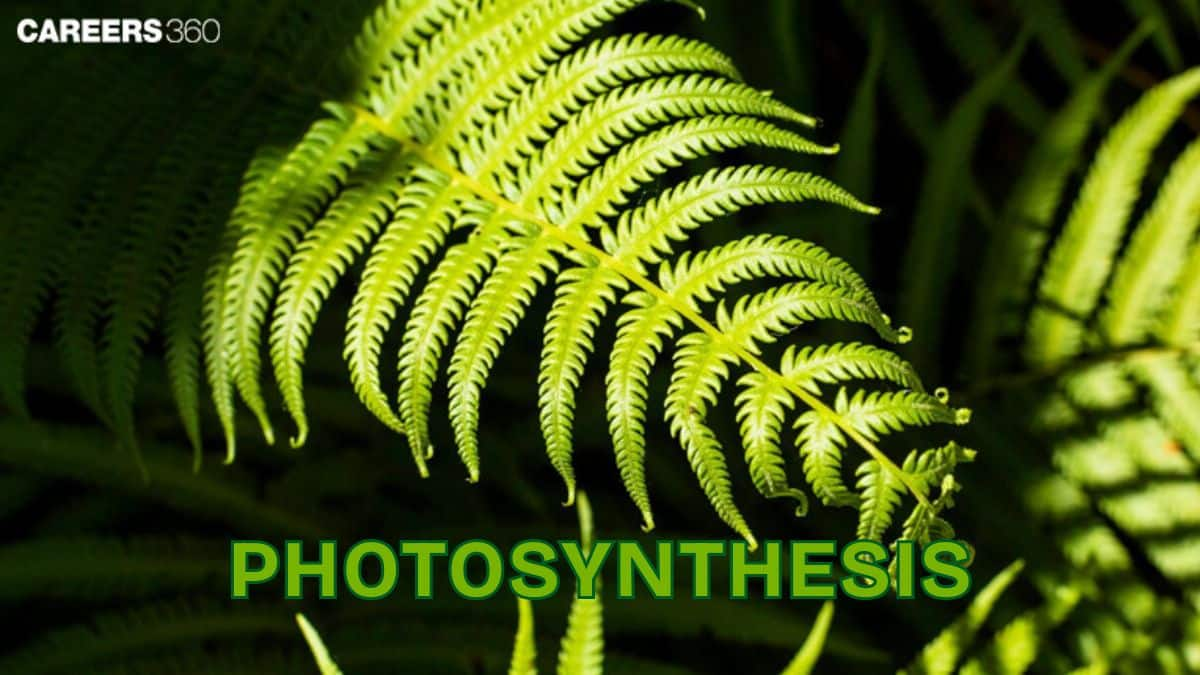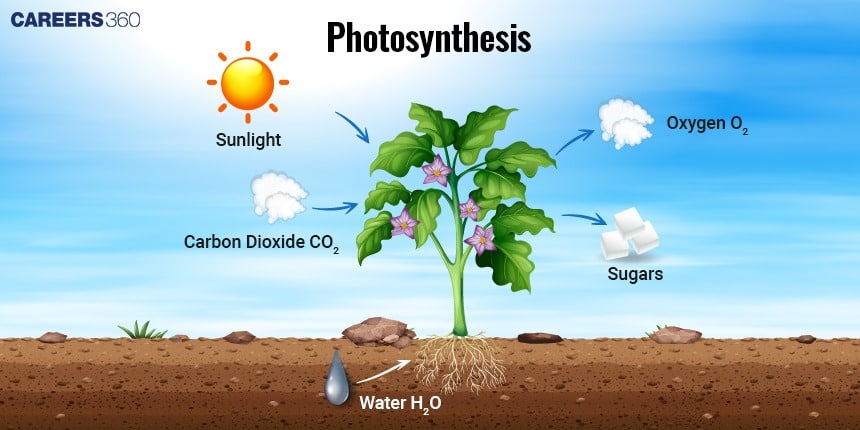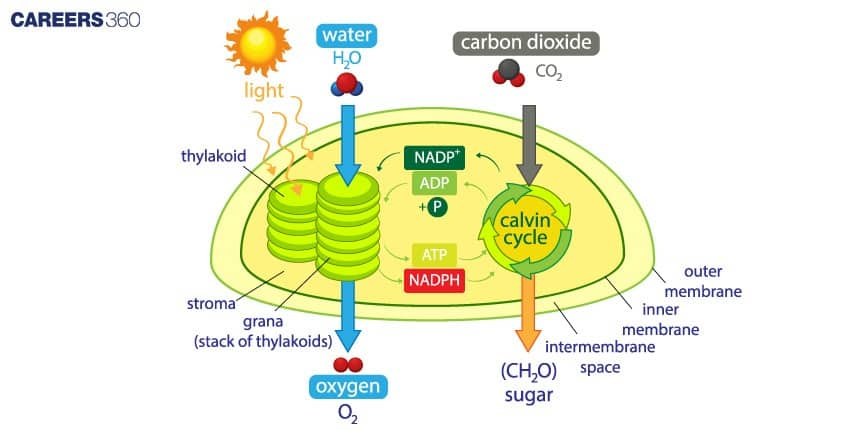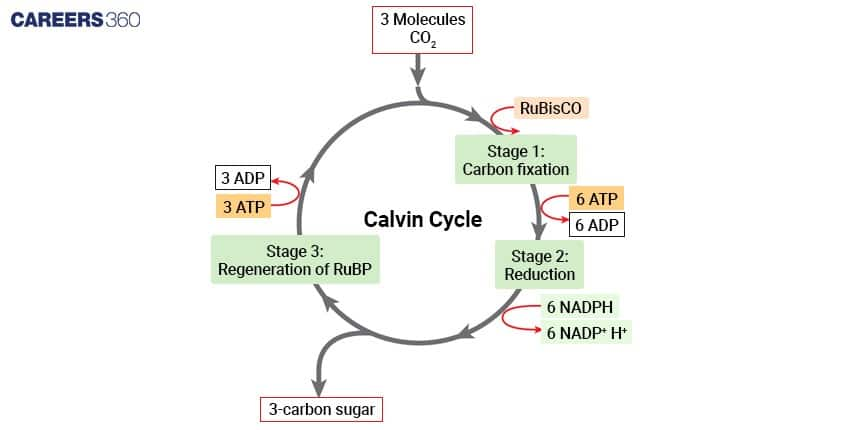Photosynthesis: Definition, Meaning, Formula, Process, Diagram, Process
Photosynthesis is the process through which green plants, algae, and certain bacteria convert light energy into chemical energy stored in glucose. This reaction, occurring in chloroplasts, not only sustains plants but also fuels all life by releasing oxygen and maintaining carbon balance on Earth. Photosynthesis is the fundamental source of energy for almost all ecosystems.
This Story also Contains
- What is Photosynthesis?
- Structure of Chloroplasts
- Photosynthetic Pigments
- Stages of Photosynthesis
- C3, C4, And CAM Pathways
- Factors Affecting Photosynthesis
- Importance of Photosynthesis
- Photosynthesis NEET MCQs (With Answers & Explanations)
- Recommended Video on 'Photosynthesis'

What is Photosynthesis?
Photosynthesis is the biochemical process by which green plants, some algae, and some bacteria convert light energy to chemical energy in organic compounds, mainly glucose. The process involves capturing light energy by organisms using chlorophyll, converting carbon dioxide and water into glucose and oxygen. All this transformation keeps the plants alive and generates power for other living organisms through the food chain.
Photosynthesis is essential for life on Earth. It is the most significant source of biomolecules for almost all living organisms, sitting at the foundation of the food chain. The oxygen that is evolved as a byproduct of photosynthesis is required for the respiration of most living organisms, including human beings. Photosynthesis also plays a very important role in controlling atmospheric carbon dioxide levels and thus, in regulating the Earth's climate. It may be represented by the general equation:
6 CO2 + 6 H2O + light energy → C6H12O6 + 6 O2
Historically, scientists like Jan Ingenhousz and Joseph Priestley contributed a lot towards the elucidation of photosynthesis, its basic principles and its requirement for light.
Structure of Chloroplasts
Chloroplasts are semiautonomous organelles present in plant cells, responsible for photosynthesis consequently have a highly specialised structure. The principal parts or structures include:
Thylakoids: Membrane-bound compartment with light-dependent reactions.
Grana: Stack of thylakoids.
Stroma: Fluid found surrounding the thylakoids where light-independent photosynthesis, Calvin Cycle, occurs.
Chlorophyll: Green pigment capturing light energy.
Photosynthetic Pigments
Photosynthetic pigments are molecules that absorb light energy for photosynthesis. The main types include:
Chlorophylls: Chlorophyll a (primary pigment) absorbs blue-violet and red light, while chlorophyll b captures blue and orange light, giving plants their green colour.
Carotenoids: These pigments absorb blue-green and violet light and reflect yellow, orange, and red. They protect plants by absorbing excess light.
Phycobilins: Found in algae, these pigments absorb green, yellow, and orange light, allowing photosynthesis in low-light conditions.
Structure of Chlorophyll
Chlorophyll is one of the major pigments in photosynthesis that captures light energy and gives green colour to plants. Understanding its working mechanism in the process of photosynthesis thus requires knowing its structure.
Molecular Structure: The molecule of chlorophyll contains a porphyrin ring—a large ring structure comprising a magnesium ion within its nucleus.
Types of Chlorophyll: There exist two main types of chlorophyll, chlorophyll a and chlorophyll b. Both are commonly found in vegetation.
Function: Chlorophyll is a green pigment that generally absorbs light in the blue and red regions of the visible spectrum, reflecting very little green light.
Stages of Photosynthesis
Photosynthesis occurs in two fundamental stages: light-dependent reactions and the Calvin Cycle. It used to be called light-independent reactions. The two stages collaboratively engage in converting light energy into the chemical energy housed within glucose.

Light-Dependent Reactions
Light-dependent reactions occur within the thylakoid membranes of the chloroplasts. Chlorophyll and other pigments absorb light energy, and the excited electrons undergo excitation. It can be represented by:
H2O → 4 H+ + 4 e− + O2
ATP Formation And NADPH Formation
Electrons excited as described are passed down an electron transport chain, where ATP and NADPH are produced.
The G3P molecules formed combine to form glucose and other carbohydrates.
The light-dependent reactions are the first of the two phases in photosynthesis, and they occur in the initial stage.
It is in these reactions that the chlorophyll contained in the light is being absorbed.
The absorbed energy of the light is transferred into chemical energy in the form of NADPH and ATP.
The reactions depend on light and occur along the thylakoid membranes of a chloroplast.
Photolysis of Water Sunlight splits water molecules to produce oxygen, protons, and electrons.
Energy from excited electrons creates ATP and NADPH through the electron transport chain.

The Calvin Cycle (Light-Independent Reactions)
The stroma of the chloroplast is the site of the actions in the Calvin cycle.
The Calvin cycle, otherwise light-independent reactions, occurs in the stroma of the chloroplasts.
CO2 is incorporated into a 5-carbon sugar (RuBP) by the ribulose bisphosphate car.
Some of the G3P produced is used in the formation of glucose and other carbohydrates, while some combine with ATP to regenerate more RuBP.
This process utilises the ATP and NADPH acquired from the light-dependent reactions to synthesise glucose from carbon dioxide.
The role of ATP and NADPH is to provide the energy and reducing power for carbon fixation and sugar synthesis.
Steps of the Calvin Cycle
Carbon Fixation: CO2 is fixed into a 5-carbon sugar (RuBP) by the enzyme Rubisco.
Reduction Phase: ATP and NADPH reduce 3-PGA to G3P.
RuBP Regeneration: ATP regenerates RuBP from G3P.

C3, C4, And CAM Pathways
The different plants show variation in the photosynthetic pathways and it seems that each one of them is adapted to some specific environment. So, C3, C4, and CAM plants have their strategies to take up the process of photosynthesis in that particular environment.
Type | Example | Environment | Key Feature |
C3 Plants | Wheat, rice | Temperature | Carbon fixation via Rubisco |
C4 Plants | Maize, sugarcane | Tropical | Uses PEP carboxylase, minimizes photorespiration |
CAM Plants | Cactus, pineapple | Arid | Fix CO2 at night to to reduce water loss |
Factors Affecting Photosynthesis
Several environmental factors affect photosynthesis and therefore its efficiency and rate. Understanding them is crucial for optimising the growth and productivity of plants.
Light Intensity: It is one of the limiting factors of photosynthesis up to a given point. The higher the light intensity, the higher the rate.
Carbon Dioxide Concentration: The level of CO2 may limit the rate of photosynthesis; higher values may result in higher rates.
Temperature: Enzymatic activities linked with photosynthesis are temperature-dependent.
Water: Availability of water is a necessity for photolysis and the general water needs of a typical plant.
Importance of Photosynthesis
Photosynthesis is essential for life on Earth. There will be many ecological implications, but photosynthesis also derives some practical benefits for the living world. As such, photosynthesis is among the most important biological processes.
Role in the Carbon Cycle: CO2 is converted into organic compounds, leading to a decrease in atmospheric CO2.
Production of Oxygen: Formulation of the oxygen.
Base of Food Chain: It serves as the basic source of energy for all trophic levels.
Agriculture and Renewable Energy: Improved crop yields and artificial photosynthesis are being researched as a means of sustainable energy production.
Photosynthesis NEET MCQs (With Answers & Explanations)
Important topics for NEET are:
Stages of photosynthesis
Factors affecting Photosynthesis
Practice Questions for NEET
Q1. Which of the following is correct for photosynthesis?
Biological oxidation process
Photochemical catabolic process
Photo-oxidative metabolism
Biological photo metabolism
Correct answer: 4) Biological photo metabolism
Explanation:
Photosynthesis is the vital biological process through which green plants, algae, and certain bacteria transduce light energy to chemical energy, primarily in chloroplasts. This conversion yields glucose.
The fundamental equation of photosynthesis is:
6 CO₂ + 6 H₂O + light energy ↦ GLUCOSE + 6 O₂
Key components of this reaction are:
1. Carbon dioxide (CO₂) - Obtained from the atmosphere via stomata.
2. Water (H₂O) - Absorbed from the soil by roots.
3. Light energy - Captured by chlorophyll pigments in leaves.
4. Glucose - Utilized for energy and cellular expansion.
5. Oxygen (O₂) - Released into the atmosphere as a byproduct.
This process is essential for life on Earth, as it generates oxygen and organic compounds necessary for the survival of most organisms.
Hence, the correct answer is option 4) Biological photo metabolism.
Q2. Oxygen is not produced during photosynthesis by
Cycas
Nostoc
Green sulphur bacteria
Chara
Correct answer: 3) Green sulphur bacteria
Explanation:
Photosynthesis -
Enzyme-regulated anabolic process of manufacture of organic compounds inside the chlorophyll-containing cells.
Since Charan Cycas come under the plant kingdom, they perform oxygenic photosynthesis. Green sulfur bacteria utilize H2S instead of H2O and perform anoxygenic photosynthesis or do not evolve oxygen.
Hence, the correct answer is option 3) Green sulfur bacteria.
Q3. Greatest proportion of photosynthesis in the world is carried out by:
trees in the rain forests of the world
trees in the temperate forests of the world
algae in oceans
irrigated crop fields
Correct answer: 3) Algae in oceans
Explanation:
Algae are the largest oxygen-producers in the world through photosynthesis, in the oceans, and these organisms are very significant in the production of oxygen. Estimates have suggested that marine plants, particularly unicellular photosynthetic algae, produce about 70% to 80% of the oxygen produced in the atmosphere. These kinds of organisms, such as Prochlorococcus, play an important role in the aquatic ecosystem and, because of photosynthesis, play a crucial role in affecting the balance of oxygen in the environment.
Hence the correct answer is option 3) algae in oceans.
Also Read:
Recommended Video on 'Photosynthesis'
Frequently Asked Questions (FAQs)
Photosynthesis is the process by which plants use sunlight to convert water and carbon dioxide into glucose and oxygen. This occurs in chloroplasts through light-dependent reactions, which capture energy from sunlight, and the Calvin cycle, which uses this energy to produce glucose. The process provides food for the plant and releases oxygen into the atmosphere.
Artificial photosynthesis is the replication of natural photosynthesis for the sustainable synthesis of fuels and chemicals, likely creating thereby a clean and renewable energy source.
Light-dependent reactions convert light energy into chemical energy in the form of ATP and NADPH, while light-independent reactions use this energy for the production of glucose from CO2.
The factors that regulate the rate of the process in plants are light intensity, CO2 concentration, temperature, and water availability.
C3 plants perform the standard photosynthetic pathway; C4 plants, adapted to high light- and temperature stress, work at reducing photorespiration as much as possible. On the other hand, CAM plants are adapted to arid environments by opening their stomata during the night.
Photosynthesis is the process through which plants convert light energy into chemical energy stored in glucose which forms the base of the food chain, and produces oxygen that is essential for life.